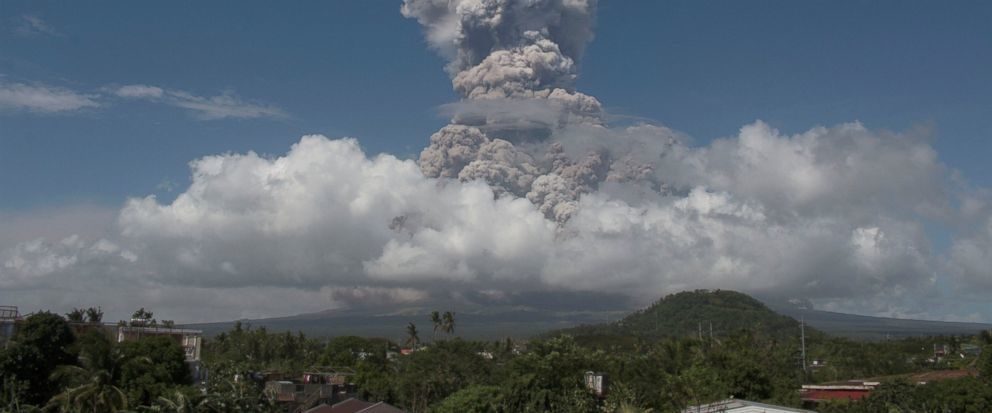
The midday explosion sent superheated lava, molten rocks and steam between 3.5 to 5 kilometers (2 to 3 miles) into the blue sky, and then some cascaded down Mount Mayon's slopes and shrouded nearby villages in darkness, Renato Solidum of the Philippine Institute of Seismology and Volcanology and other officials said.
From the crater, the deadly debris billowed about three kilometers (1.8 miles) down on the southern plank of Mayon toward a no-entry danger zone. There were no immediate reports of deaths or injuries, officials said.
The explosion was the most powerful since the volcano started acting up more than a week ago.
Due to its relatively gentle eruption last week, thousands left emergency shelters and returned to their communities in Legazpi city outside the danger zone. But Monday's blast sent nearly 12,000 fleeing back to evacuation centers, raising the number of people in those shelters to more than 30,000, Yucot said.
Authorities on Monday raised the alert level to four on a scale of five, which means an explosive eruption is possible within hours or days. A danger zone around Mayon was expanded to 8 kilometers (5 miles) from the crater, which means thousands of villagers will have to leave their homes, officials said.
Airplanes were ordered to stay away from the crater and ash-laden winds and several flights were canceled.
Volcanic ash fell in about a dozen towns in coconut-growing Albay province, where Mayon lies, and in nearby Camarines Sur province, with visibility being heavily obscured in a few towns because of the thick gray ash fall, Jukes Nunez, an Albay provincial disaster response officer, said by telephone.
"It was like night time at noon, there was zero visibility in some areas because the ash fall was so thick," Nunez said.
Ashfall in Brgy Masarawag, Guinobatan Albay. 1:11pm pic.twitter.com/FfjwIi81dB
— Saleema Refran (@saleema_refran) January 22, 2018
Makapal na abo ang bumalot sa buong paligid sa Guinobatan, Albay pic.twitter.com/FsTP8CHBJ1More than 30,000 ash masks and about 5,000 sacks of rice, along with medicine, water and other supplies, were being sent to evacuation centers, Office of Civil Defense regional director Claudio Yucot said.
— Saleema Refran (@saleema_refran) January 22, 2018
Mayon lies about 340 kilometers (210 miles) southeast of Manila. With its near-perfect cone, it is popular with climbers and tourists but has erupted about 50 times in the last 500 years, sometimes violently.
In 2013, an ash eruption killed five climbers who had ventured near the summit despite warnings. Mayon's first recorded eruption was in 1616 and the most destructive, in 1814, killed more than 1,200 people and buried the town of Cagsawa in volcanic mud. The belfry of Cagsawa's stone church still juts out from the ground in an eerie reminder of Mayon's fury.
The Philippines lies in the "Ring of Fire," a line of seismic faults surrounding the Pacific Ocean where earthquakes and volcanic activity are common.
In 1991, Mount Pinatubo in the northern Philippines exploded in one of the biggest volcanic eruptions of the 20th century, killing about 800 people.
Source: Associated Press




Comment: UPDATE (25.01.18)
Mayon volcano, which has been erupting for almost two weeks in the Philippines, still appears to be swelling with magma under the surface, scientists said earlier today. More than 74,000 people are staying in dozens of emergency shelters as the volcano continues to belch lava, ash and superheated gas and rocks. Officials are worried the eruption may last months, affecting the education, health and livelihoods of people in its shadow.
The Philippine Institute of Volcanology and Seismology said tremors, pyroclastic flows and emissions of sulfur dioxide were detected Wednesday and early Thursday. Lava erupting up to 500 meters (1,640 feet) high was spilling down the slope, with one lava flow extending 3 kilometers (1.8 miles) from the crater. Ash plumes still rising up to 5 kilometers (3 miles) high have spread ash onto farms and towns nearby, darkening the skies and forcing villagers to wear masks.
The institute said GPS and other measurements indicated a sustained swelling or inflation of the mountain surface, which was consistent with magma rising and creating pressure. The alert level for Mayon remains four on a scale of five, indicating a violent eruption may be imminent.
See also: String of earthquakes and volcanic eruptions hits Ring of Fire - at least five events in two days